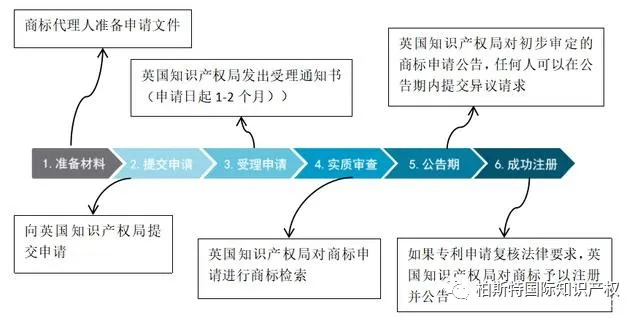- European

-
trademark law
The current laws include the 1994 Trademark Act, which came into effect on October 31, 1994, and the 1994 Trademark Regulations, which were amended in 1996 and 1998 respectively. The UK trademark includes Great Britain (England, Wales, Scotland), Northern Ireland, the Isle of Man, and the British Indian Ocean Territory, but does not include Ireland and the Channel Islands.
-
Registered types
Text trademark, sound trademark, graphic trademark, color trademark, and combinations of the above types
-
Prohibited registration situations
1. Aggressive, such as containing profanity or pornographic images;
2. Directly describing the goods or services related to it, for example, the term 'plastic' cannot be used as a trademark of a plastic bag production company;
3. Misleading, such as using the term 'organic' to refer to non organic goods;
4. Too ordinary, without distinctive features, such as statements like 'we lead the trend';
5. General shapes related to the applicant's business, for example, if the applicant sells bananas, the shape of bananas cannot be used as a trademark;
6. Using national flags that are not authorized for use, utilizing official symbols or inspection marks, such as coat of arms. -
Duration
The protection period for trademark rights in the UK is 10 years, and an application for renewal must be submitted in advance before the expiration of 10 years.
-
Revocation system
Revocation must meet the following conditions:
1. The trademark has been registered for at least five years;
2. Not used for five consecutive years after registration;
3. Not used without justifiable reasons. -
Participating countries' treaties and organizations
Stockholm International Convention, Madrid Protocol on International Registration, Madrid Agreement on False Indications of Origin, Nice Agreement, Hague Certification Convention, Trademark Law Treaty, World Intellectual Property Organization, joined the Madrid Protocol on December 1, 1995, and is a pure member of the Protocol. The goods and services are classified according to the International Nice Classification. National English abbreviation: GB。
-
Registration method
direct registration
Staged registration
1. Single country application: submit the application directly to the UK Intellectual Property Office (UKIPO)
2. Madrid International Registration: The United Kingdom joined the Madrid Protocol on December 1, 1995, allowing for the designation of the United Kingdom through Madrid International Registration.

It is necessary to determine the application category and specific goods/services, and submit the trademark design.
Review whether the submitted documents meet the formal requirements and whether the materials are complete.
Including a review of absolute reasons.
In addition, in October 2007, the UK made changes to its legislation, allowing the registry to search for prior rights and allowing only prior rights holders to be notified in cases where a conflict of prior rights is deemed to exist, but no longer as a registration barrier on relative grounds as before. If there is a prior similar trademark, the examiner will issue a notice to the applicant, who will decide whether to continue applying for the trademark. During this period, the applicant has one opportunity to defend themselves in order to persuade the examiner to give up notifying the prior rights holder, such as providing substantial differences in the trademark or goods/services. If the examiner cannot be convinced and the applicant decides to continue the application, the examiner will directly notify the prior rights holder and publish the application in the Trademark Gazette.
The public notice period is two months, and any third party may raise objections.
If no third party raises objections during the public notice period, the registration will be approved two weeks after the expiration of the objection period.
1. Submit the applicant's name, address, and nationality;
2. Provide the Chinese or foreign name of the trademark;
3. Provide clear trademark designs;
4. If your trademark is in color, you must specify which color. If you submit a trademark in black and white, you can use any color in the future;
5. The category of goods or services applied for;
6. Fill out one application form, which must be signed by the applicant or by an agent.




